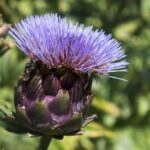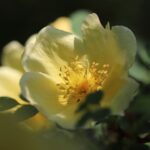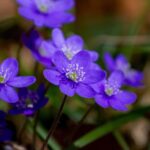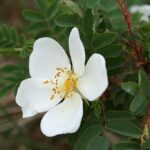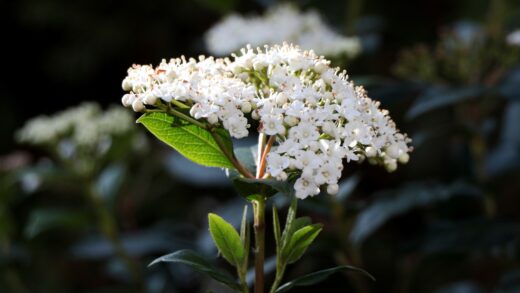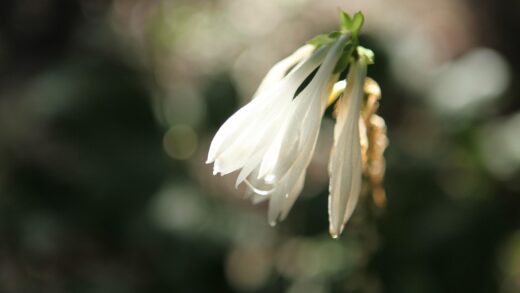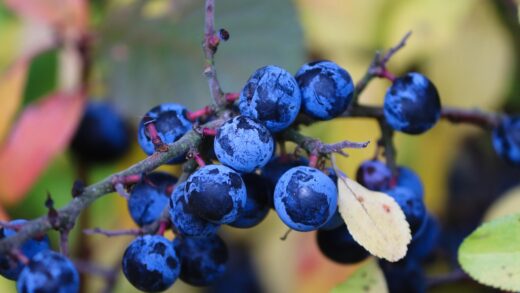The Abyssinian gladiolus, known scientifically as Gladiolus murielae, is a truly special and elegant plant originating from the mountainous regions of Southeastern Africa, particularly Ethiopia (formerly Abyssinia), from whence its common name also derives. Its appearance is extremely attractive; on long, slender stems, it bears snow-white, gracefully nodding flowers, the center of which is adorned with a dark red, star-shaped blotch, creating a dramatic contrast with the purity of the petals. These flowers captivate not only with their appearance but also with their pleasant, sweet fragrance, which enchants garden lovers, especially in the evening hours. The plant reveals its full splendor in late summer and early autumn, when many other garden flowers have already faded, becoming a valuable splash of color in the late-season garden. The leaves are long, narrow, and grass-like, light green in color, which also contributes to the plant’s airy, elegant appearance. Its height generally reaches 60-90 centimeters, making it excellent as a cut flower, retaining its freshness and decorative value in bouquets for a long time. It is important to note that, although it belongs to the gladiolus family, its appearance and requirements differ somewhat from the more well-known, large-flowered hybrid gladioli, representing a kind of finer, more natural charm. From a botanical perspective, it is a perennial cormous plant, meaning that each year it regrows from its underground storage organ, the corm, provided that suitable conditions are ensured.
Introduction and Botanical Characteristics of the Abyssinian Gladiolus
The Abyssinian gladiolus, also known as the fragrant gladiolus or acidanthera, is a perennial cormous plant from the Iridaceae family, whose native habitat is East Africa, primarily the higher-altitude grassy areas of Ethiopia and Malawi. This origin also determines some of its needs, such as a preference for well-drained soil and a sunny location. Botanically, it is classified in the genus Gladiolus, although it was previously also known as a separate genus, Acidanthera, from which one of its common names is derived. The plant’s corms are relatively small, globose, with a fibrous tunic, and from these, long, narrow, sword-shaped, bright green leaves emerge in the spring, forming the base of the plant’s foliage.
Flowering typically occurs in the latter half of summer, in August and September, when other garden plants are beginning to fade, thus providing a refreshing sight in the garden. The flowers are arranged in loose racemes on a long, slender flower stalk that can reach 60-100 cm in height, and a single stalk can usually develop 5-10 flowers. The flowers themselves are funnel-shaped, composed of six snow-white, elegantly arching petals, in the center of which is a prominent, chestnut-brown or dark red, star-shaped blotch, giving the flower a unique character. This contrasting coloration and the fine, sweet fragrance of the flowers, reminiscent of jasmine, make this plant truly special and attractive, with the fragrance being particularly intense in the evening hours.
The morphological characteristics of the Abyssinian gladiolus also include a relatively thin but strong flower stalk that, although slender, usually supports the flowers well; however, in windy locations, it may be beneficial to provide it with support. The leaves are typically grass-like, narrow and long, directed vertically upwards, so the plant’s habit is airy and elegant. The corm renews itself each year; above the mother corm, a new, larger corm develops, while the lower, used portion dies, and at the base of the new corm, small lateral cormels, also known as offsets, may also form, which can serve as a basis for propagation.
It is important to mention that, although the plant is perennial, its corms are frost-sensitive in many climates, and therefore their overwintering must be ensured, similar to other non-hardy gladiolus species. This means that in autumn, before the first hard frosts, the corms must be lifted from the ground and stored in a frost-free, airy place until the next spring planting. With proper care and overwintering, one can enjoy the flowering of this exceptionally beautiful and fragrant plant year after year, which can be a true jewel in any flower bed or even in container plantings.
More articles on this topic
Selecting the Ideal Planting Site and Soil Preparation
One of the key elements for the successful cultivation of the Abyssinian gladiolus is the careful selection of a suitable planting site. This plant is markedly sun-loving, so a spot in the garden should be found where it will receive at least six to eight hours of direct sunlight daily. Shady or semi-shady locations hinder flowering, the stems may become leggy, and the number of flowers may be reduced; even the intensity of the fragrance can diminish. Beds facing south or southwest can be ideal, where the plant abundantly receives the sun’s warmth and light, which is necessary for the proper development of the corms and a rich flower production.
Soil quality is also a decisive factor for the Abyssinian gladiolus. The optimum is well-drained soil with a loose structure and rich in nutrients. Standing water is extremely detrimental to the corms and can easily cause rot, so low-lying, clayey, compacted soils should be avoided. If the garden soil is heavier, its structure must absolutely be improved by adding sand, fine gravel, or mature compost to ensure rapid drainage of excess water. Regarding soil pH, neutral or slightly acidic (pH 6.0-7.0) is most favorable.
When preparing the soil before planting, it is recommended to loosen the selected area to a depth of at least 25-30 cm so that the roots can spread easily and the corms can develop properly. This is also an opportunity to improve the soil’s nutrient content. Incorporate mature manure or compost into the soil, which in the long term provides the necessary nutrients and improves soil structure and water retention capacity without causing waterlogging. The use of fresh manure should be avoided, as it could damage the corms.
Wind protection can also be an important aspect, especially if growing taller specimens. Although the stems of the Abyssinian gladiolus are relatively strong, a stronger gust of wind can damage them, and the flowers can break. A more sheltered but sunny corner can be an ideal choice or, if necessary, discreet support should be provided for the plants. The right location and careful soil preparation lay the foundation for the plant’s healthy development and abundant flowering, so these steps should definitely be given sufficient attention.
More articles on this topic
The Planting Process and Choosing the Planting Time
The most suitable time for planting Abyssinian gladiolus corms is spring, when the danger of late frosts has passed and the soil temperature has consistently risen above 10-12°C (50-54°F). This usually means the period from late April to mid-May in many temperate climates, but it is advisable to monitor current weather forecasts. Planting too early can cause frost damage to the emerging plants, while planting too late can delay flowering or even prevent it entirely in the current season. By choosing the optimal time, one ensures that the plant has enough time to develop its root system and foliage before the late summer flowering.
Planting depth is crucial for stable growth and adequate flowering. As a general rule, corms should be planted at a depth equal to two to three times their size, which usually means a depth of 8-12 cm (3-5 inches). In lighter, sandy soils, one can plant a little deeper, while in heavier soils, planting is shallower. Regarding planting spacing, at least 10-15 cm (4-6 inches) of space should be left between individual corms so that the adult plants have enough room to grow and air can circulate properly between them, thus preventing possible fungal diseases.
During planting, the corms should be placed in the prepared planting hole with the pointed end upwards. After positioning them, they should be carefully covered with soil, and then the soil around them should be lightly pressed to ensure good soil contact. After planting, the area should be watered thoroughly to promote rooting. If planting Abyssinian gladiolus in larger groups, a much more impressive effect is achieved than if they are planted singly in the garden; a group of 5-7 corms already forms a beautiful clump.
It is also possible to start the corms indoors early if earlier flowering is desired. For this purpose, corms can be planted in pots in March and kept in a bright, frost-free place (e.g., in a greenhouse, conservatory, or on a sunny windowsill) until transplanting outdoors. When the danger of frost has passed, the pre-sprouted plants can be carefully transplanted outdoors, along with the soil ball. This method can be particularly useful in regions with cooler climates where the growing season is shorter.
Care of the Abyssinian Gladiolus During the Growing Season
Caring for the Abyssinian gladiolus during the growing season does not require overly complicated tasks, but a few basic things should be attended to for abundant flowering and healthy growth. One of the most important tasks is regular but moderate watering, especially during drier, hotter periods. The soil should be kept moderately moist, but overwatering and standing water should be avoided, as this can lead to corm rot. As the flowering period approaches, as well as during flowering itself, the plant’s water needs increase somewhat, and then more attention should be paid to an adequate water supply.
Nutrient supply also plays an important role in the quality and quantity of flowers. If the soil was well prepared with organic matter at the time of planting, less additional fertilization will be needed during the season. However, if the soil is less fertile or if the plant is grown in a container, it is advisable to water with a complex liquid fertilizer that promotes flowering every 2-3 weeks during the growing period. Excessive nitrogen application should be avoided, as this can lead to excessive foliage growth at the expense of flowering. Preparations richer in potassium and phosphorus are more beneficial.
Regular removal of weeds is essential, as these compete with the gladiolus for water, nutrients, and light. When weeding, one should proceed carefully to avoid damaging the shallowly located corms or young shoots. Mulching the soil surface (e.g., with pine bark, compost, or straw) can help control weeds, conserve soil moisture, and stabilize soil temperature, which can be particularly useful during summer heat.
Although the stems of the Abyssinian gladiolus are generally quite strong, taller specimens, especially in windy locations or if they bear many flowers, may require support. A thin bamboo stake or a discreet plant support can help prevent the stems from toppling or breaking. Faded flowers should be removed regularly (deadheading), which is not only important from an aesthetic point of view but also because it prevents seed formation, allowing the plant to direct its energy towards developing new flowers and strengthening the corm.
Propagation Methods for the Abyssinian Gladiolus
Propagation of the Abyssinian gladiolus can basically be done in two ways: vegetatively, by separating the lateral cormels (offsets), and generatively, by sowing seeds. The most common and also the simplest method is propagation by cormels, as this ensures that the new plants are genetically identical to the mother plant, thus retaining all its favorable characteristics, including flower color and fragrance. These small corms form at the base of the mother corm, i.e., on the basal part of the new, developing corm, towards the end of the growing season.
For propagation by cormels, it is necessary to carefully separate these small formations, often the size of a grain of rice or slightly larger, from the corms lifted and cleaned in autumn. The separation can be done immediately after lifting, during cleaning, or even in spring, before planting. It is important to use only cormels that are healthy, intact, and firm. These small corms can be planted the following spring, similar to the mother corms, but a little shallower (about 3-5 cm or 1-2 inches deep) and more densely in a well-prepared bed or even in a pot, in a separate growing area.
Plants grown from cormels generally do not flower in the first year; depending on their size, it may take them 1 to 3 years to reach a flowering size. In the first year, they usually only develop leaves, and their corm grows. It is important that, even during this period, they receive proper care: regular watering, weed removal, and, if necessary, nutrient supplementation. Young corms grown in this way should be lifted and overwintered in autumn in the same way as adult specimens, until they reach a size at which flowering can be expected.
Propagation by seed is a longer process that requires more patience, and the offspring obtained in this way may not necessarily retain all the characteristics of the mother plant, especially if there has been a possibility of hybridization. Seeds can be collected from the capsules that form after the faded flowers, once they have dried. Sowing is done in spring, in a loose, well-drained sowing medium, covering the seeds lightly. Germination can take several weeks, and the young seedlings are very small and delicate. Plants grown from seed generally need 3 to 5 years to develop a flowering-sized corm, so this method is mainly used by gardeners with an experimental spirit or by plant breeders.
Overwintering Corms and Ensuring Next Year’s Bloom
The Abyssinian gladiolus is not winter-hardy in many climates, so its corms must be lifted from the soil each autumn, before the arrival of the first more intense frosts. This is generally relevant at the end of October or the beginning of November, but it is advisable to monitor the evolution of weather conditions and the state of the plant. The yellowing and drying of the leaves signal that the plant has completed its vegetative cycle and that the corm has entered dormancy. For lifting, the soil around the plant should be carefully loosened with a digging fork, taking care not to damage the corms.
Soil residues should be carefully removed from the lifted corms, but these should not be washed, as moisture can cause rot during storage. The stem and leaves should be cut back, leaving a stub of about 5-10 cm (2-4 inches). Subsequently, the corms should be dried and “cured” for a few weeks in a well-ventilated, warm, and dry place (e.g., in a shed, garage, or even on a tray covered with newspaper in a less heated room of the house). This process, known as curing, helps in wound healing and in the strengthening of the outer tunics, which reduces the risk of diseases during storage.
After drying, completely dry stem residues, old and dead roots, and the remains of the old corm from the previous year, which is usually found beneath the new, larger corm, should be removed from the corms. This is also an opportunity to separate the previously mentioned cormels, which can be stored separately and cultivated later. The cleaned and healthy corms should then be stored in a frost-free, cool (ideally between 5-10°C or 41-50°F), dark, and well-ventilated place until spring planting. A cellar, an unheated garage, or a pantry may be suitable for this purpose.
For storage, paper bags, cardboard boxes, or net bags, or possibly crates, can be used, which are loosely filled with dry peat, sawdust, vermiculite, or sand, so that the corms do not come into contact with each other and to ensure adequate air circulation. Occasionally, once a month, it is advisable to check the stored corms and remove any possibly moldy or softened specimens to prevent the further spread of infection. Careful overwintering ensures that, the following spring, healthy and vigorous corms can be planted that will delight us again with their wonderful flowers.








